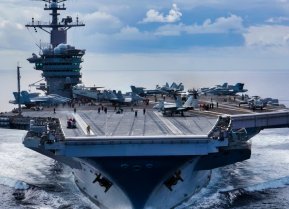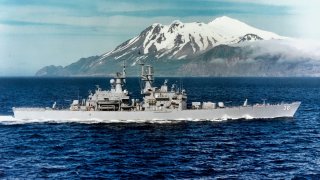California-Class Nuclear-Powered Cruisers: A U.S. Navy Asbestos Mess
Even though the California-class cruisers were nuclear-powered, which minimized expenditures for fueling the ships, the hefty costs associated with operating both California and South Carolina were debilitating.
Summary and Key Points: The U.S. Navy's California-class cruisers, developed in the 1970s, were among the first nuclear-powered missile cruisers and were designed to counter the growing Soviet submarine threat. These heavily armed ships, featuring advanced missile systems and nuclear reactors, represented cutting-edge naval technology.
-However, the high operational costs and asbestos-related issues significantly impacted their long-term viability. With the collapse of the Soviet Union and the introduction of the more cost-effective Ticonderoga-class cruisers, the California-class was eventually phased out.
-Despite their short service life, these cruisers marked an important era in naval warfare innovation.
From Cutting-Edge to Costly: The Short-Lived Era of California-Class Missile Cruisers
The U.S. Navy missile cruisers developed in the 1950s possessed some of the newest and most cutting-edge weapons systems available on existing hulls.
To counter the rapidly growing Soviet threat, the Navy prioritized its sea-based capabilities.
Before the Second World War, a ship was designated a cruiser when its primary missions involved raising enemy commerce and generally engaging in enemy ships of equal or lesser size. Over the years, however, the cruiser designation grew to refer to defense vessels surrounding an aircraft carrier.
By the time the Cold War began heating up, the U.S. and the Soviet Union were rapidly expanding their respective submarine fleets, rendering the need for more advanced nuclear-powered defensive shifts.
Introducing the California-class cruisers:
Prior to the California-class cruisers, the Navy relied on its Belknap-class predecessors. These singe-ended guided-missile cruisers were originally developed by the 1960’s. The ships were designated as destroyer leaders (known today as frigates) and were later re-classified as guided missile cruisers.
Armament-wise, the Belknap-class ships could pack a punch. Armed with a twin-rail RIM-2 Terrier Mk 10 Missile Launcher, the cruisers could launch RURi-5 ARSOS. Belknap-class cruisers were also fitted with two twin-caliber guns and later were outfitted to spot RIM-67 Standard missiles. Once these cruisers hit the water, the Navy began developing its successor class.
Specs and capabilities:
The USS California (CGN-36) was the fourth nuclear-powered cruiser to ever enter service with the U.S. Navy.
This cruiser led its class, which were all built between 1970 and 1975. The USS California was joined by the USS South Carolina.
Like its predecessor, this class of cruisers was armed to the teeth. Each ship in this class featured 2 Mk 13 missile launchers which used RIM-66D Standard missile air targets. Additionally, the ships carried 4 single Mk 32 torpedo tubes, each capable of using Mk 46 anti-submarine torpedoes.
Naval Encyclopedia has outlined additional specs and capabilities surrounding the California-class cruisers: “These missile cruisers defined as “fleet escorts” (“cruisers” in 1975) were defined from the experiments carried out on USS Truxtun and USS Bainbridge in nuclear propulsion. They were the first of this type in “serial” production. Extremely expensive they used a new generation of reactor, the D2G whose lifetime of the heart was three times longer. Their arrangements required the adoption of a long and massive hull without recess, returning to this standard defined in the thirties. Their armament was much larger than previous cruisers, including two of the new 127 mm Mk42 guns, two launchers of the new standard SAM, and one ASROC.”
Rising costs and asbestos plagued the California-class’ long-term survival in the fleet:
Even though the California-class cruisers were nuclear-powered, which minimized expenditures for fueling the ships, the hefty costs associated with operating both California and South Carolina were debilitating.
Once the Soviet Union collapsed, the Navy could no longer justify its massive budget concerning the California-class vessels. Additionally, the newer Ticonderoga-class cruiser
Besides its price tag, the California-class cruisers faced asbestos issues. The cruisers’ manufacturer, Newport News Shipbuilding and Dry Dock, used asbestos pretty extensively in its construction as thermal insulation for pipes.
The consequences have been detailed by Shrader & Associates: “Asbestos lagged pipes were common in all ships built before the late 1970s, including the nuclear-powered California. The absence of boilers did not preclude the use of asbestos in engineering spaces, in fact, the increase in piping and the lagging to insulate it caused by the several cooling systems required by nuclear power may have increased it. Asbestos-lagged pipes ran throughout the ship, in nearly every compartment. Maintenance requirements regarding asbestos and potential for exposure began to be promulgated in the late 1970s and early 1980s, they were often ignored. Asbestos insulation was not scheduled to be removed unless it was damaged or required to support other maintenance.”
What about the Virginia-class cruisers?
The California-class cruisers’ successor- the Virginia-class- was no more successful in its service history.
Although the Virginia vessels were given a 38-year service life trajectory, all ships in this class were decommissioned less then 14 years after first setting sail for the Navy. The cruisers in this class received a New Threat Upgrade in the early 1980s, which included a large overhaul aimed at enhancing the ship’s responses to modern threats.
Due to this enhancement, in addition to other notable specs and capabilities possessed by the Virginia-class boats, this class did prove to be ideal escorts for the fast-powered aircraft carriers in the service like the Nimitz-class ships.
However, similar cost constraints suffered by the California-class plagued its long-term success.
About the Author
Maya Carlin is an analyst with the Center for Security Policy and a former Anna Sobol Levy Fellow at IDC Herzliya in Israel. She has by-lines in many publications, including The National Interest, Jerusalem Post, and Times of Israel. You can follow her on Twitter: @MayaCarlin.
All images are Creative Commons.


